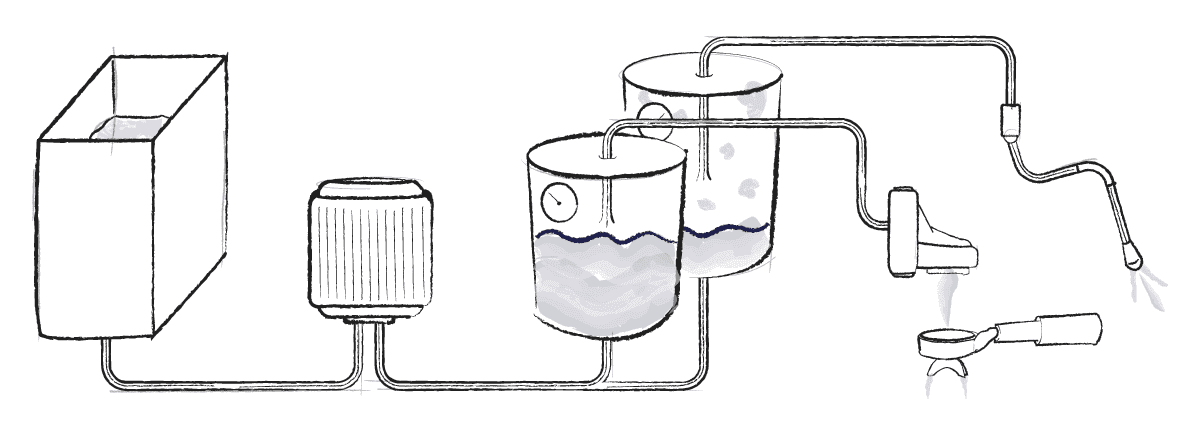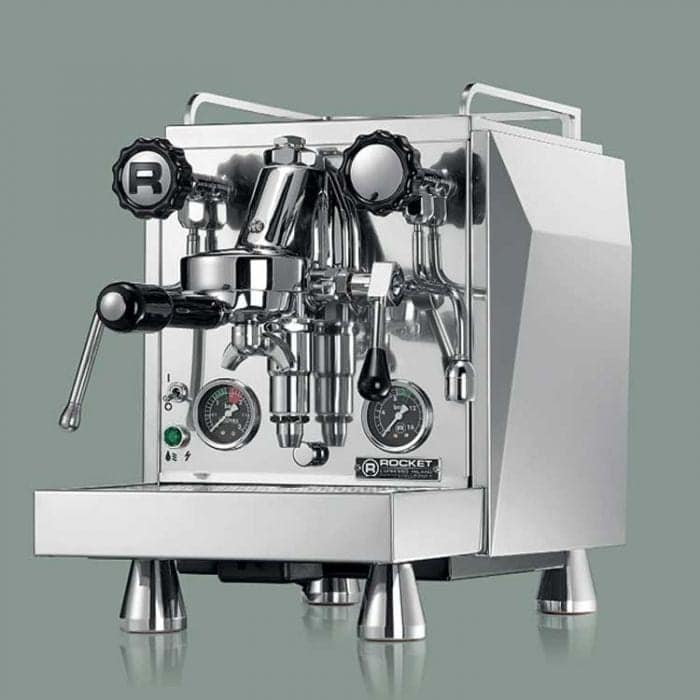An Espresso machine underneath all the fancy bells, whistles and chrome is like a forest of wires with metals and screws in it. The basic mechanism by which most machines brew an espresso is by forcing pressurized water near boiling point through a “puck” of ground coffee and a filter, producing a thick concentrated coffee called espresso.
The first espresso machine was invented in 1884 by Angelo Moriondo of Turin, Italy. Since then, innumerable designs have been innovated and manufactured and most of them share some common parts.
Simply put, they all do the same thing i.e force hot water through finely ground coffee. Some machines may also come with a steam wand which is used to steam and froth milk for drinks like cappuccino and caffe latte.
You can vary the taste of espresso in the same machine by varying the fineness of the grind or the amount of pressure used to tamp the grinds.
Experienced baristas prefer pulling espresso shots directly into a pre-heated demitasse cup or shot glass because this helps them maintain a higher temperature of the espresso.
Espresso machines can either be steam-driven, piston-driven, pump-driven, or air-pump-driven. They are also available as manual or automatic. Get affordable, high-quality espresso machines from ECM in UAE through UAE Ekuep. To make things simpler, here is a list of what every part of a basic espresso machine does:
Reservoir – The Water Source
All espresso machines need a water system which is usually determined by the capacity of the machine. Water can either be sourced through a small reservoir or directly from a plumbed mains connection.
Reservoirs are placed in machines with smaller volumes while a high capacity professional machine uses a piped source.
A reservoir is basically a removable container that is filled up with water by hand. It lets you control the water quality as compared to direct plumbing that uses tap water.
A reservoir will hold the cold water that’ll be used to prepare the espresso. It is neither pressure-tight nor is it heated yet. Heat and pressure are applied once the water is pulled into the pump and the boiler.
Pump
To push water from the reservoir into a pack of finely ground coffee, machines need pressure and that’s where the pump comes in.
It pushes the water into the heating chamber at high pressure. The pump needs to apply 9 bars of pressure which is almost equal to 130 psi.
Espresso machines used in earlier times had pistons attached to large levers and baristas would manually pull these levers to force the water into the coffee. Hence the phrase “pulling a shot”.
There are two kinds of electric pumps, the vibratory pump, and the rotary vein pump. Commercial espresso machines come with a rotary pump to supply constant pressure while domestic machines are featured with a vibration pump.
Vibratory pumps are smaller, cheaper and easier to replace while rotary pumps are quieter, consistently pressured and generally more durable.
Boiler/Heating Chamber
The boiler/heating chamber is a sturdy, stainless-steel structure that has a heating element attached within a groove at the bottom.
This is the component where water coming from the pump is heated. Most espresso machines come with electric heating elements to boil the water.
A simple coiled wire, such as that in a filament of a light bulb or in an electric toaster, gets hot when the machine is turned on and becomes inert when turned off. A one-way valve in the heating chamber ensures that the water doesn’t go back into the pump from the chamber.
The size of the boiler may vary depending on the capacity of the machine. The bigger it is, the more drinks it will produce. Commercial machines usually have a double boiler system.
So they have one boiler solely for brewing, and one for the steam wand. Water temperature has a major impact on the strength of the coffee and varying temperatures can alter the taste of the shot.
Double boilers make it easy to have different temperature needs because the water for brewing has to be at 93℃ (200℉) whereas for steam it needs to hit a 100℃ (212℉).
Grouphead
Coming in from the heating chamber, the water now lands in the grouphead. This component passes the hot, pressurized water through the bed of coffee placed in the portafilter inside it.
A grouphead comprises of a Portafilter, a place for the portafilter to attach, a passage to start the pump, and a pathway for the water to go into the portafilter.
A grouphead will have several tiny holes so that the water can pass through with an even, cross-sectional flow through the ground coffee. While domestic traditional espresso machines have one grouphead, commercial machines often have more than one.
Portafilter
A portafilter is a portable, removable filter which consists of a metal filter basket set inside a handle with two-pronged spout.
The portafilter is that part of the machine that holds coffee grounds. The basket also has two spouts at the bottom from which the espresso comes out and flows into the cup.
Finely ground coffee is placed in the filter basket and then compressed by a tamp, before being locked into the machine. The portafilter is then attached to the grouphead component to seal it.
Portafilters come in varying sizes but the two most commonly used are the 53mm and 58mm. The 58mm is used for commercial espresso machines but both of them can facilitate the same quantity of ground coffee when attached to correct baskets.
Always make sure you buy the corresponding size tamp because even the smaller tamp won’t evenly compress all of the coffee in a if used on a bigger portafilter.
Steam Wand
The steam wand produces steam to heat and froth milk for use in a variety of espresso drinks. This wand, if present in the machine, is connected to the heating chamber. When the valve is activated to steam position, steam from the heating chamber is released out of the wand and into the milk.
Control Panel
The control panel comprises of an on/off switch, two indicator lights, and a control valve. The lights show when the machine is turned on and when optimum temperature has been reached.
The control valve activates the flow of water through the portafilter, or it may start the flow of steam from the steam wand. Two micro-switches control the pump and heating temperature.








